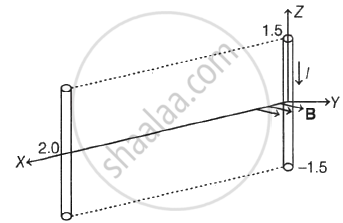Advertisements
Advertisements
प्रश्न
In a series LCR circuit, the phase difference between the voltage and the current is 45°. Then the power factor will be ______.
विकल्प
0.607
0.707
0.808
1
उत्तर
In a series LCR circuit, the phase difference between the voltage and the current is 45°. Then the power factor will be 0.707.
Explanation:
Let, Inductance = L
Conductance = C
Resistance = R
Frequency = f
Phase Difference between current and voltage = `phi`
As, in LCR circuit,
Power Factor = `cos phi`
Substitute the given values from,
`phi = 45^circ`
`cos 45^circ = 1/sqrt(2)`
Therefore, P.F = 0.707
APPEARS IN
संबंधित प्रश्न
Obtain an expression for average power dissipated in a purely resistive A.C. circult.
A resistor of 500 Ω and an inductance of 0.5 H are in series with an AC source which is given by V = `100 sqrt2` sin (1000 t). The power factor of the combination is ______.
Prove that an ideal capacitor in an AC circuit does not dissipate power
(a) An emf e = e0 sin ωt applied to a series L - C - R circuit derives a current I = I0sinωt in the circuit. Deduce the expression for the average power dissipated in the circuit.
(b) For circuits used for transporting electric power, a low power factor implies large power loss in transmission. Explain.
An AC source generating a voltage e = e0sinωt is connected to a capacitor of capacitance C. Find the expression for the current i flowing through it. Plot a graph of e and i versus ωt.
A light bulb is rated 100W for 220 V AC supply of 50 Hz. Calculate
- resistance of the bulb.
- the rms current through the bulb
An AC circuit consists of only an inductor of inductance 2 H. If the current is represented by a sine wave of amplitude 0.25 A and frequency 60 Hz, calculate the effective potential difference across the inductor. (π = 3.142)
A 25 μF capacitor, a 0.10 H inductor, and a 25Ω resistor are connected in series with an AC source whose emf is given by e = 310 sin 314 t (volt). What is the frequency, reactance, impedance, current, and phase angle of the circuit?
What is meant by wattles current?
L-C-R series circuit contains a resistance of 10 Ω and self-inductance 0.4 H connected in series with variable capacitor across 60 V and 50 Hz supply. The value of capacity at resonance will be π2 = 10.
An alternating e.m.f. of 0.2 V is applied across an LCR series circuit having R = 4 `Omega`, C = 80 µF and L = 200 mH. At resonance the voltage drop across the inductor is ____________.
In series 'LR' circuit and in series 'RC' circuit, same current is flowing. If the frequency of e.m.f. of a.c. is increased for both the circuits, the impedance will ____________.
In series LCR circuit, resistance is 18 `Omega` and impedance is 33 `Omega`. An r.m.s. voltage of 220 V is applied across the circuit. The true power consumed in a.c. circuit is ____________.
The voltage gain of a CE amplifier is 50. A sinusoidal ac of amplitude 10 mV is applied as a signal. The output of the amplifier will be ______.
Two unknown resistances are connected in two gaps of a meter-bridge. The null point is obtained at 40 cm from left end. A 30 Ω resistance is connected in series with the smaller of the two resistances, the null point shifts by 20 cm to the right end. The value of smaller resistance Ω is ______.
In series LCR circuit R = 18 Ω and impedance is 33 Ω An rms voltage 220V is applied across the circuit. The ture power consumed in AC circuit is ______.
A conductor lies along the Z-axis at −1.5 ≤ Z ≤ 1.5 m and carries a fixed current of 10.0 A in −az direction as (see figure). For a field B = 3.0 × 10−4`"e"^(−0.2"x")`ay T, find the power required to move the conductor at constant speed to x = 2.0 m, y = 0 in 5 × 10−3 s. Assume parallel motion along the x-axis.

The power factor of LCR circuit is ______.
Explain the theory of an AC circuit with a resistor.
Where is the power dissipated in an alternating current circuit?
